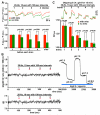Motile axonal mitochondria contribute to the variability of presynaptic strength
- PMID: 23891000
- PMCID: PMC3757511
- DOI: 10.1016/j.celrep.2013.06.040
Motile axonal mitochondria contribute to the variability of presynaptic strength
Abstract
One of the most notable characteristics of synaptic transmission is the wide variation in synaptic strength in response to identical stimulation. In hippocampal neurons, approximately one-third of axonal mitochondria are highly motile, and some dynamically pass through presynaptic boutons. This raises a fundamental question: can motile mitochondria contribute to the pulse-to-pulse variability of presynaptic strength? Recently, we identified syntaphilin as an axonal mitochondrial-docking protein. Using hippocampal neurons and slices of syntaphilin knockout mice, we demonstrate that the motility of axonal mitochondria correlates with presynaptic variability. Enhancing mitochondrial motility increases the pulse-to-pulse variability, whereas immobilizing mitochondria reduces the variability. By dual-color live imaging at single-bouton levels, we further show that motile mitochondria passing through boutons dynamically influence synaptic vesicle release, mainly by altering ATP homeostasis in axons. Thus, our study provides insight into the fundamental properties of the CNS to ensure the plasticity and reliability of synaptic transmission.
Copyright © 2013 The Authors. Published by Elsevier Inc. All rights reserved.
Figures




References
Publication types
MeSH terms
Substances
Grants and funding
LinkOut - more resources
Full Text Sources
Other Literature Sources
Molecular Biology Databases

